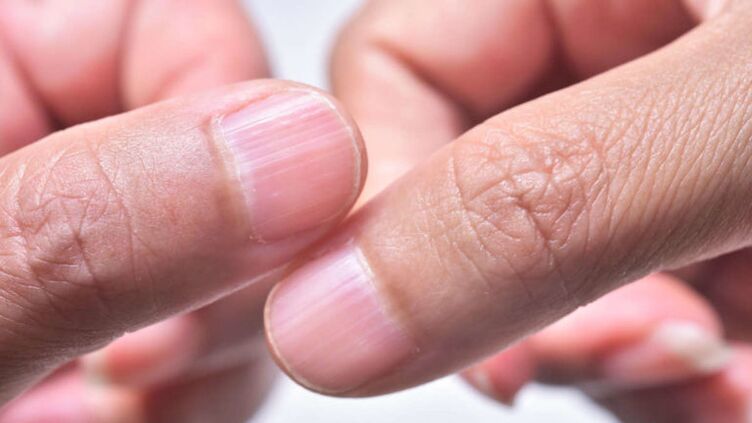
Nail psoriasis is a special form of psoriasis in which the nails and / or feet are affected. Doctors call this disease psoriatic nail dystrophy (from the Greek language.toenail- nail,hard- violation,Tropic- dish).
From this article, you will learn about the causes of the development of nail psoriasis, its symptoms, which do not always indicate an accurate diagnosis, as well as dangerous misconceptions. about this form of the disease.
Note.There are many pictures in the article that may not prepare the reader well.
Where do nails come from?
To understand the problem of nail psoriasis, it is important to understand how nail apparatus works.
Nails have two functions: work and beauty. First, nails protect the fingertips from damage, increase accuracy and acumen when working with small objects, it can be an offensive or defensive weapon, and finally a nail helps. we get itchy. Second, the aesthetics or aesthetic function of the nail is also very important, especially for women.
Nails are formed from the outermost layer of the skin - the epidermis. The manicure apparatus includes:
- nail plate - directly the nail itself,
- matrix - it produces nail plates,
- the nail hole, or nail hole, is the only visible part of the matrix, this is the white moon-shaped area at the base of the nail,
- eponychium - nail roller protects the matrix from above from damage,
- nail bed - is under the nail plate and is responsible for attaching it to the nail part of the finger,
- hyponychium - the transition zone between the nail bed and the scalp of the finger.
Causes and development mechanisms of nail psoriasis
In its course - with periodic exacerbations and remission - psoriasis on the nail looks like a vulgar form of the disease.
It is believed that nail psoriasis develops for the same reasons and follows the same pattern as typical psoriasis outbreaks. Among these reasons, external and internal factors are distinguished.
Intrinsic factor is genetic predisposition. External causes are many and include, such as trauma, poor diet, intoxication (alcohol and tobacco), infections, and certain medications.
The standard mechanism of the development of nail psoriasis under the influence of these reasons can be briefly described as follows:
- Triggers, such as trauma, activate immune cells.
- The activated immune cells migrate to the area of the foundation or nail bed.
- Immune inflammation develops in these areas.
- The division of skin cells is greatly accelerated and their maturation is interrupted.
- There are characteristic symptoms of psoriasis on the nails.
Additionally, nail psoriasis can be attributed to the body's inability to adapt to adverse environmental conditions. According to this view, the main cause of psoriasis is an evolutionary alien habitat.
As a result, this evolutionary approach considers unhealthy diet, lack of sunlight and clean water, excess toxins, lack of normal physical activity, sleep disturbances, and chronic stress. are the direct causes of illness.
Nail psoriasis and psoriatic arthritis are linked
The link between nail damage and psoriatic arthritis has long been known.
Based on observations, scientists found that psoriatic arthritis was accompanied by nail damage in 9 out of 10 cases.
But the mechanism of this connection has not been fully studied. However, the authors of several studies, for example, from the Institute of Molecular Medicine in Leeds (UK), have attempted to explain this association beyond the concept of immunitis.
In their view, the fact that the knuckle is located next to the nail and is anatomically related to it.
Therefore, micro-trauma and the Kebner phenomenon that causes primary arthritis - psoriatic arthritis - also causes secondary pathological changes in the nearest nail.
This is why psoriatic arthritis is associated with such frequent nail damage.
%20of%20the%20toe.jpg)
As such, the symptoms of nail psoriasis are often a manifestation of psoriatic arthritis.
Let us now consider the main myths that accompany this disease, and how dangerous they are.
Myth 1: Nail psoriasis is very rare.
Not really. Obviously, with psoriasis, nails are damaged very often.
According to various sources, nail psoriasis occurs in between 6% and 82% of psoriasis vulgaris cases. Such widespread popularity in assessing the prevalence of this pathology is explained by problems in its accounting. Medical statistics record the visits of doctors in the first place by patients with a vulgar appearance, and the attention to the nails in the second place. In scientific research, nail psoriasis cases are also often studied only outside of the main subject of interest - psoriasis with external lesions.
However, some publications say that
up to 80-90% of patients with vulgaris psoriasis report recurrent nail damage.
And nail psoriasis also occurs in 90% of patients with joint psoriasis and scalp psoriasis.
It should be noted that most often adults have this form of the disease.
According to various sources, in children, nails are affected in about 7-37% of psoriasis cases. Unfortunately, often the manifestations of psoriasis on a child's nails are not taken seriously. Parents or doctors believe this is a variation of the standard or consequence of an injury, or they simply don't notice due to the mild severity of symptoms.
Myth 2: Recognize nail psoriasis with easy symptoms
In fact, this is not always the case. The truth is
Nails can only react to various diseases with a limited number of symptoms. Therefore, the manifestations of different nail diseases may be similar.
Of course, it is possible to suspect nail psoriasis if the patient has severe symptoms of psoriasis vulgaris. However, nail damage can be small compared to skin damage and can be easily ignored by a doctor.
Normally, the more vigorous the psoriasis is on the skin, the more severely damaged the nail is.
First of all, the nail is affected.
It is also important to know that in 5% of cases, nails may be the only initial manifestation of psoriasis. That is, the classic manifestations of psoriasis on the skin may be completely absent.
What nail psoriasis looks like depends on where the pathological changes originated - in the matrix or nail layer.
The origin of the symptoms - the matrix or the bed of the disease - is important to consider when choosing a treatment. Therefore, it is necessary to define it correctly.
Symptoms stemming from nail matrix are:
- tremor symptoms,
- white spots and spots (leukonychia),
- red dot on the hole,
- crumpled nails.
Although the cause of these symptoms is on the matrix level, as the nail grows, pathological changes appear on the nail plate.
Symptoms, which cause the nails, are:
- nail peeling (onychomycosis),
- vertical bleeding,
- subcutaneous hyperkeratosis,
- symptoms of an oil stain.
Next, we'll go into each individual symptom in depth. And let's start with matrix derived expressions.
Shivering symptoms
A sign of a thorn appears on the surface of the nail plate with holes or pits, resembling a dent in a tube.
Such defects mainly occur on the nails, but they rarely appear on the feet. As the nail grows, the pits move from the nail fold to the edge of the nail plate.
The pits in nail psoriasis are often deep, large, and chaotic. They arise due to the sloughing off of loose clusters of cells from the nail surface, in which division and keratinization are impaired.

The more severe the psoriasis, the more likely the tremor will appear.
However, it should be noted that, in addition to psoriasis, nail pits are also characteristic of alopecia areata (alopecia areata), eczema, dermatitis, and can also occur, for example. such as a fungal infection.
Counting the total number of pits on all nails will help with an accurate diagnosis.
- Below 20 - atypical for psoriasis,
- from 20 to 60 - psoriasis can be suspected,
- more than 60 - confirmed psoriasis diagnosis.
White spot (leukonychia)
Leukonychia is a symptom manifested by white spots or spots on the nail.
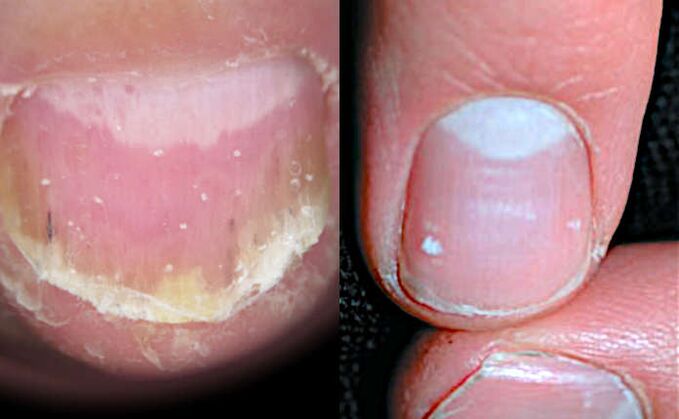
With leukonychia (from Greek.leukós- white andtoenail- fingernails), in contrast to superficial pitting in the symptoms of prickly disease, impaired cell division and keratosis lie in the thickness of the nail plate. At the same time, the nail surface is still smooth and shiny. And the white color of the spots arises from the reflection of light from the loosely laid clusters of cells.
However, some studies show that leukocytes are so common in healthy people that it is not a characteristic symptom of psoriasis. For example, a nail injury can cause leukocytes.
Broken nails
When superficial pitting (roughness) and deep white blood cells (white spots) merge, the nail begins to break.
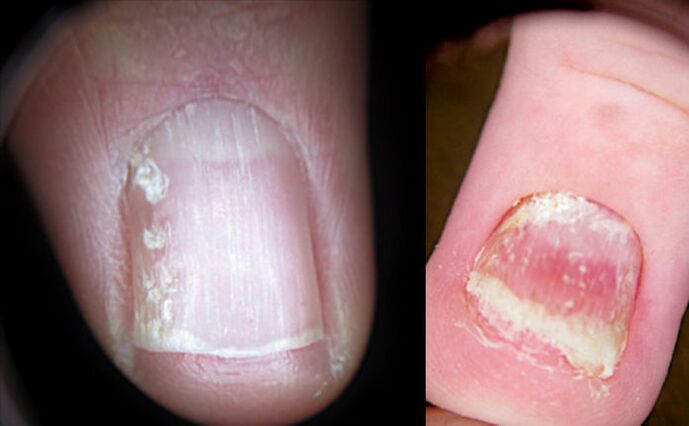
Most often, nail cracking occurs with perennial nail psoriasis.
And the more intense the inflammation of the nail matrix, the more damaged the nail plate is. In some serious cases, the nail can completely collapse and fall out.
Red dot on nail socket
Apparently, red spots in the hole area and its general red streak occur due to an increase in blood flow to the vessels under the nail.
In addition, red spots on the hole are formed due to a structural violation of the nail itself: it becomes more transparent and thinner. And because of this, first, the blood vessels become more obvious, and second, the thin nail plate puts less pressure on the blood vessels below, and they are more blood filled.
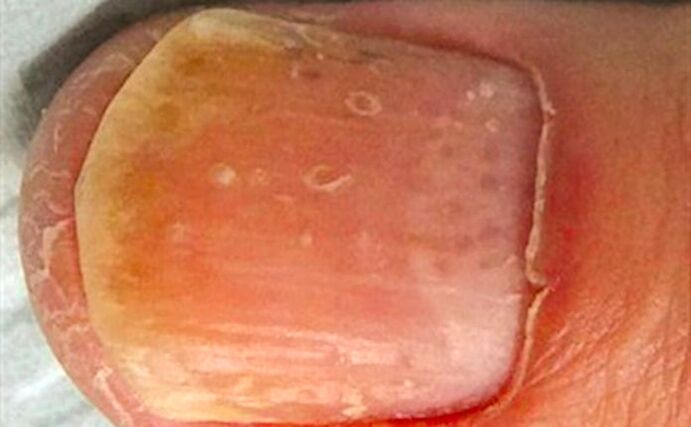
Thinning nails can also cause the entire nail to be reddened.
Nail clipping (onychomycosis)
Now let's consider the symptoms, the source of which is the nail bed.
Numbness is the separation of the nail from the bed due to the accumulation of cells under the nail that are impaired in division and keratinization.

The antifungal itself (from Greek.toenail- nails andλύσις- separation) is not necessarily an indication of psoriasis and can develop, for example, from nail trauma.
Initially, the loss of contact between the nail and the bed occurs in the subcutaneous area - along the outer edge of the nail plate. The onychomycosis then gradually spreads toward the nail folds in a semicircular shape. Exfoliating areas turn white due to a buildup of air under the fingernail.
A red border (scientific erythema) along the edge of onychomycosis, often visible on the fingers, is characteristic of psoriasis and helps to make an accurate diagnosis.
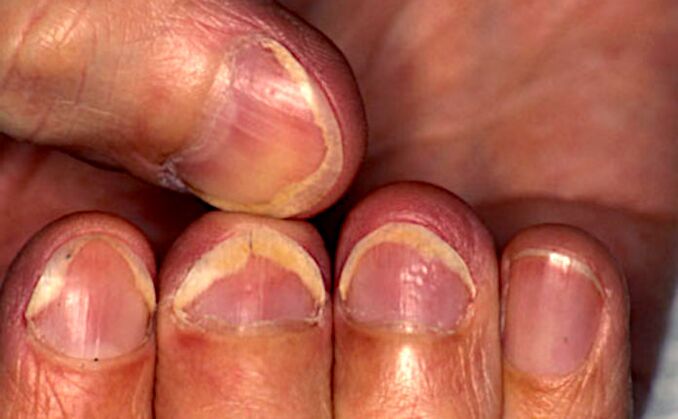
When the onychomycosis is prolonged, the nail layer loses its properties and the new nail grows, most likely it will not be able to attach normally. Therefore, even when the nail is completely renewed, the onychomycosis usually persists.
Due to the fact that onychomycosis facilitates bacteria and fungus entry, infection can join. This sometimes leads to discoloration of the nail. For example, a green color can appear when bacteria are attachedPseudomonas aeruginosa(Pseudomonas aeruginosa) and others.
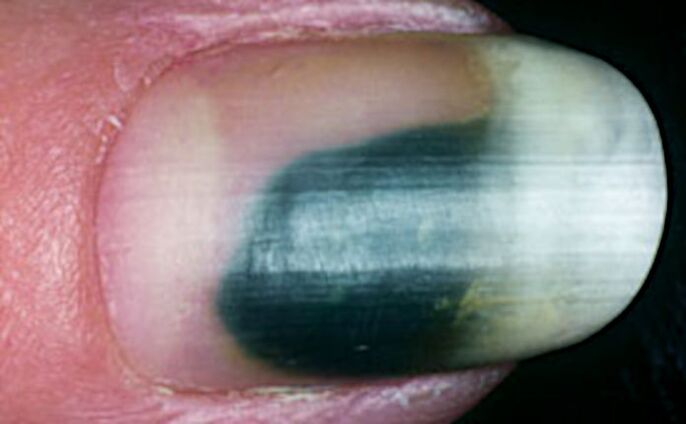
Bleeding along the skin
Bleeding along the nail plate and appear as dark red lines 1-3 mm long.
Increased blood flow and edema in the inflammatory area of the nail leads to rupture of capillaries, manifested in the form of such hemorrhage.
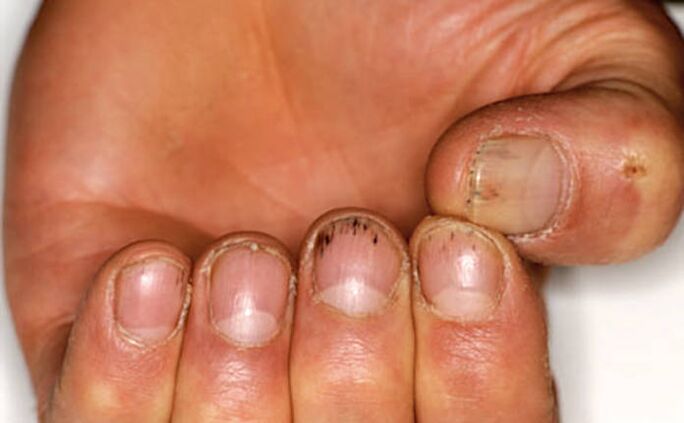
Due to the peculiarities of the blood supply, most cases of hemorrhage occur near the free edge of the nail - in the area of the skin under the nail.
Hyperkeratosis under the skin
Subcutaneous hyperkeratosis is the accumulation of dead cells under the outer part of the nail.
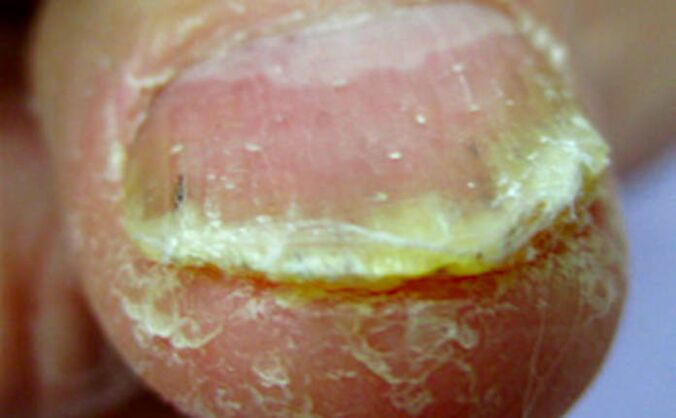
With psoriasis, subcutaneous hyperkeratosis (from Greek.super- excessive andkeras- horn) is usually silvery white, but can also be yellow. And when the infection joins, it can become, for example, green or brown.
The higher the nail is raised than the nail bed, the higher the activity of the pathological process.
On the finger, sub-nail hyperkeratosis is usually manifested by loose layers under the nail plate. In the legs, these blocks are tightly welded with a thick nail.
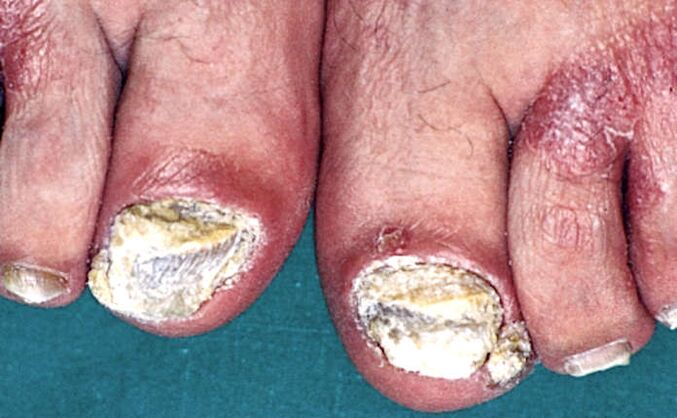
In addition, psoriasis with toenail lesions is characterized by a combination of subcutaneous hyperkeratosis with onychomycosis (clipping on nails).
Symptoms of oil stains
Signs of an oily stain appear under the fingernail as yellow-red (salmon) patches.
They arise on the foundation near the nail fold and migrate towards the edge of the nail as it develops.
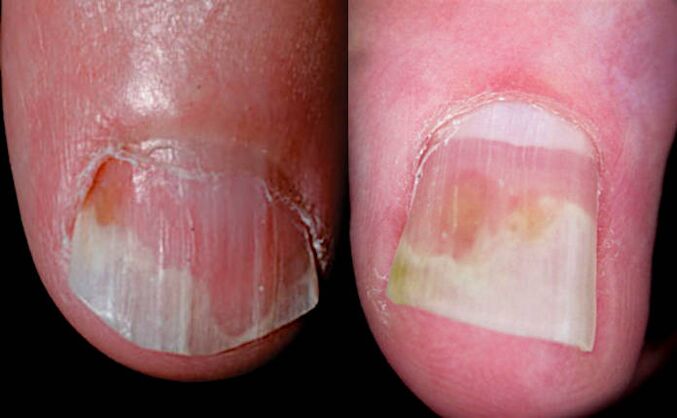
The cause of this symptom is the inflamed nail layer with capillary dilation and accumulation of cells involved in the inflammatory process, as well as impaired cell division and keratinization.
Oil stains come in many different shapes and sizes. They can be found both on the center of the nail and on the edge, next to the onychomycosis.
Myth 3: Psoriasis in the nail is only a cosmetic problem.
In fact, this is not true. Although more than 90% of patients report psoriasis nails is not very good, this is not just a cosmetic problem.
According to various studies, nail psoriasis significantly reduces the patient's quality of life:
- 52% of patients also complain of pain,
- 59% - for problems in everyday activities,
- 56% - for problems at home and
- 48% - for problems at work.
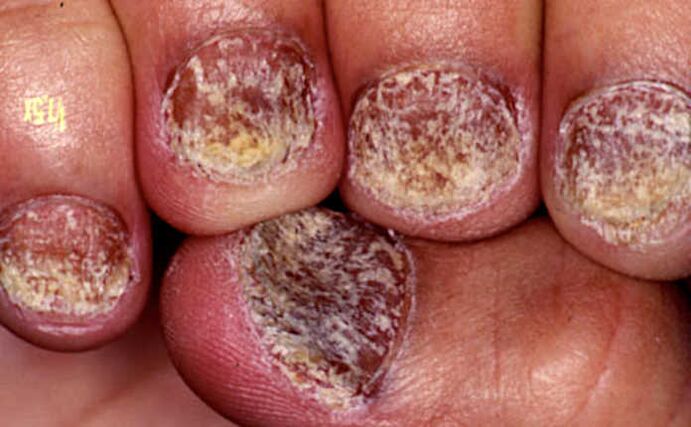
Therefore, it is very important to make an accurate diagnosis and initiate treatment as soon as possible, as improving the condition of the nail will significantly improve the quality of life of the patient with psoriasis.
Myth 4: Nail psoriasis is not dangerous
In essence, this is not an example. Talking above about the cause of this form of the disease, we wrote that
Nail psoriasis is an important symptom of psoriatic arthritis.
It is important to remember that the outward manifestations of arthritis may be completely absent. In this case, we can not only talk about the fact that the finger and toe joints are affected, but may also involve spinal and pelvic joints.
You can check the joint for arthritis with an ultrasound (ultrasound) or magnetic resonance imaging (MRI) scan.

Even in the absence of obvious symptoms of arthritis, but manifestations of nail psoriasis, it is very important to ensure that all joints are in order.
And then regularly monitor the condition of the joints. Otherwise, psoriatic arthritis can be easily missed! A late diagnosis will lead to late treatment and, as a result, irreversible joint damage and disability.
So, if your doctor does not ask for an insurance study, on the grounds that there are no obvious signs of arthritis, you must contact the clinic yourself and undergo an ultrasound, such as an ultrasound. on a paid basis.
How to Diagnose Nail Psoriasis |
It is important to be able to recognize many of the symptoms of nail psoriasis, which we have described above, as they help in making an accurate diagnosis. But since nail changes characteristic of psoriasis can also occur with other diseases, it is difficult to make an accurate diagnosis immediately.
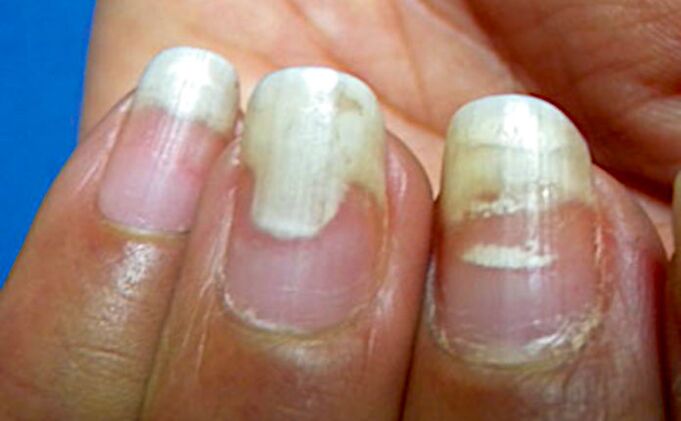
In this case, the presence of several symptoms on different nails at the same time can help with the diagnosis.
The important signs of psoriasis on the nail are:
- a symptom of psoriasis: more than 20 pits on all fingernails of the hand indicate the possibility of psoriasis and more than 60 pits confirm the diagnosis of psoriasis,
- peeling nails (onychomycosis) with a red border around the edge,
- Oil stains (salmon) on the nail.
Difficulty diagnosing nail psoriasis with a single symptom
It is especially difficult to diagnose nail psoriasis if it appears only one symptom.
For example, if it shows only onychomycosis on the hands or just subcutaneous hyperkeratosis in the arms and / or legs.
The only reliable method of making a reliable diagnosis for isolating fungal nail disease (peeling off nails) is probably to study fungal dermatosis using a special microscope - a microscope.
For this, a high magnification skin microscope is used. Please note that the hand held microscope does not provide the required magnification. It is essential that a video dermoscope has a magnification of at least 40 times. Then, the dilated capillary rings characteristic of psoriasis become apparent.
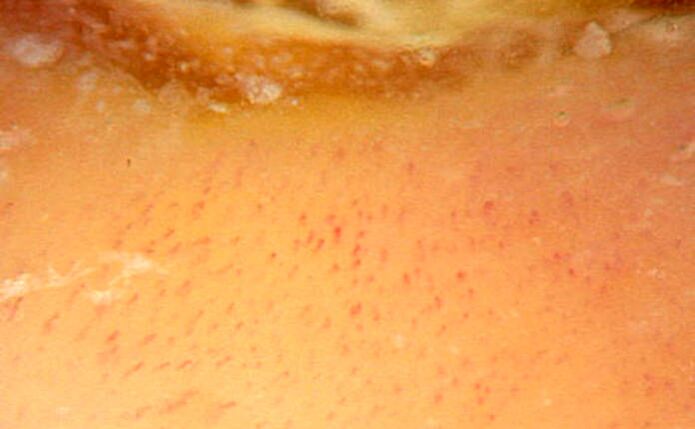
With isolated subungual hyperkeratosis, the likelihood of psoriasis is high if the buildup of scales is silvery white, as well as if all the nails on the hands or feet are affected.
Psoriasis or nail fungus?
About 30% of patients with nail psoriasis also have a fungal infection - scientifically fungal onychomycosis.
Externally, hyperkeratosis and onychomycosis (clipping of nails) in psoriasis can resemble manifestations of a fungal infection. Therefore, it can be difficult to perform differential diagnosis, that is, to determine the true cause of the changes in the nail plate.
Furthermore, both psoriasis and fungus can affect the same nail at the same time. Most of it occurs on the toes and is mainly characteristic of older patients.
In addition, when a fungal infection occurs, one or both of the nails in the big toe are often affected. In psoriasis, as a rule, several nails are affected at the same time.

The following symptoms are beneficial for psoriasis:
- oil stains and / or signs of calluses on the nail,
- signs of psoriasis on the scalp and / or large folds of the skin,
- periodic remission and exacerbation of nail damage.
In support of onychomycosis, they say:
- vertical stripes on the affected nail,
- detection of fungus during microscopic examination of a scrape treated with potassium hydroxide from the affected nail (KOH test),
- cultures were positive for the fungus.
In general, based solely on external manifestations, it is not possible to completely rule out onychomycosis in psoriasis patients.
Also keep in mind that a fungal infection can cause Kebner phenomena on the nail and surrounding skin, leading to psoriasis symptoms. So anyway
It is helpful to see a therapist and do a fungal test and if found, start antifungal therapy.
Key findings and things to do
Let's summarize important information about nail psoriasis and its symptoms.
Diagnostic features:
- Nail psoriasis is very common but is often overlooked.
- The symptoms of nail psoriasis can be mild and often overlooked by experts.
- In 5% of cases, nail damage may be the only symptom of newly started psoriasis.
- Manifestations of different nail diseases may be the same, which complicates the diagnosis.
The main manifestations of nail psoriasis:
- a symptom of a thorn - pits in the nail,
- White dots,
- broken nails
- red dots in the hole area,
- detachment of the nail,
- bleeding along the skin,
- subcutaneous hyperkeratosis - loose clusters under the nail,
- symptoms of an oil stain.
Psoriasis and fungi:
- Most often, nail psoriasis is accompanied by a fungal infection.
- In order to definitively rule it out, it is necessary to contact a fungus researcher and conduct additional studies.
Nail psoriasis and psoriatic arthritis:
- Nail psoriasis is a common companion of psoriatic arthritis.
- It is important to detect pathological changes in the joint as soon as possible to initiate prompt treatment, avoiding irreversible complications and disability.
- Even in the absence of outward symptoms of arthritis, but nail psoriasis is detected, it is necessary to examine the joints with an ultrasound or MRI.

























